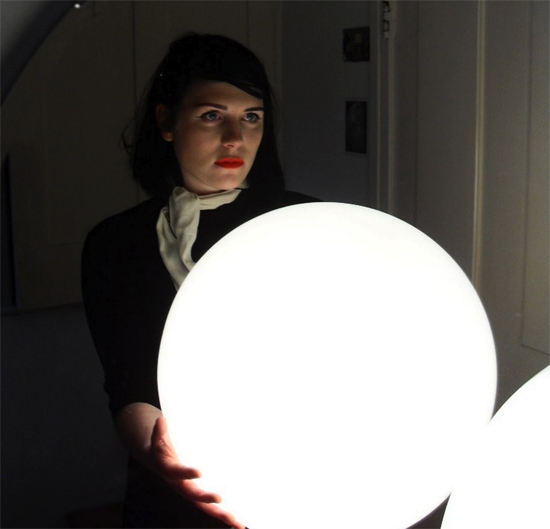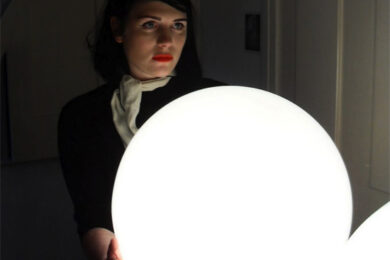The concept of mindfulness features in both clinical psychology and Buddhism. A rough definition goes along the lines of ‘bringing one’s complete attention to the present experience on a moment-to-moment basis’. Or put more simply, living in the ‘now’.
In the modern world, many people’s minds are rarely in the ‘now’. They are either raking over past events, or stuck on a fast-forward into the future in which they plan, scheme and hypothesise. Technology has, perhaps, catalysed this mindset – witnessing fellow gig-goers constantly film and tweet, instead of actually enjoying the show, is a depressingly common experience. This lack of mindfulness can be exhausting, and results in failure to acknowledge all sorts of simple pleasures.
So, meeting up with Astrud Steehouder to discuss her Paper Dollhouse project would seem akin to therapy for many people. Astrud appears to spend a healthy amount of time living in the moment. Her haunting, minimal, debut solo album A Box Painted Black is a deeply illuminating snapshot of its creator, a set of songs which, in the most part, were written only minutes before they were recorded.
Steehouder has already released a mightily impressive album with her band Rayographs, but the trio’s swirling guitar fuzz is a seismic step away from Paper Dollhouse’s distant folk, murmured confessionals and filmic soundscapes.
We meet in a Camden bistro and from the moment my first question settles, Astrud is a torrent of ideas, musings and wonderfully tangential conversational off-cuts. It seems that she is processing her thoughts on the spot – these are not rehearsed answers – and to talk to her for an hour is a glorious insight into how her mind works. At one point, we find ourselves chatting about the Quaker Sunday school she attended as a child, and in the days after the interview Astrud emails me links to short films by one of her favourite artists, James Turrell. Steehouder’s mindfulness is addictive: Paper Dollhouse is one of life’s fleeting moments of clarity.
How long have you had the idea to record some solo material?
Astrud Steehouder: Oh, God – forever. I’ve always messed around doing my own stuff and it has always been in a different format. It’s been much more intuitive, not that Rayographs isn’t intuitive, but it has been very much more a spontaneous thing.
Have you always been someone who experimented with music?
AS: Yes. Friends of my parents had a piano and I would just shut myself in the room for about four hours when I was about seven. I think they thought I was a bit of a freak but I just liked making sounds. I did violin lessons for about six years and went up the grades, but it wasn’t really me. I couldn’t create the sound of a violin being played well, but I did like the idea of being able to play. I don’t have the patience to learn anything up to the point where I am good at it. But I do like the tone of a violin – I’ve got one sitting at the end of my bed at the moment. I want to create some sounds with it. That’s all I’m interested in really – sound.
What was the songwriting process like for Paper Dollhouse?
AS: Well, there was a patch recently when Rayographs weren’t doing band stuff for a little while. I had that creative energy to do something but it wasn’t really being fulfilled, so it turned inwards I guess. When I made the album, I basically got a Mac and I had all these songs in my head. It all came so quickly and almost everything on the album is first-take recordings of songs I’ve pretty much written ten minutes before I recorded. It was almost making it up as I went along. The piano track ‘Ice Storm’ was an older one, which I liked and sounded right, but all the other ones came from a surge of complete folk songs that I had in my mind.
Are you always that ‘in the moment’?
AS: I do things spontaneously. It’s not that I can’t think about things, or don’t think about things but I’m not very good at planning. I’ll just do things the way they come to me with pretty much everything. Also, I was writing with my friend Nina [Bosnic]. She’s a photographer and a musician. She very much captures the moment. She doesn’t set up the shots for a million hours and she is able to catch the essence of what it is at the time. She sees the potency of that.
When did you realise you had an album’s worth of songs?
AS: I didn’t intend it to be an album. I put these songs together, and it’s so under produced it’s ridiculous, which is ironic. I am quite into the idea of production, which you cannot hear on the album. Everything is so lo-fi that I quite like it. I quite like the idea of capturing things as they are, in any form. I was just going to do it as a CD-R, as I quite liked it as it was anyway. It needed to be a CD-R to mirror the quality, and I was going to do homemade packaging with muslin and wax stamps.
The album is released via Jane Weaver’s Bird label, as part of Finders Keepers. What do you think attracted her to paper Dollhouse?
AS: I think the lo-fi nature was what Jane picked up on.
When I listen to A Box Painted Black, it is almost feels voyeuristic, like I’m eavesdropping.
AS: I guess it was weird that I was happy to release something of that nature, in a way, as it is extremely personal. It is one part of me. In some ways it is like an open book, but in other ways I really like the complexity of what I know goes behind it comes out in this extremely pencil-drawing sort of way.
But aren’t pencil drawings incredibly powerful, as they portray so much with so few strokes?
AS: Absolutely. My mum is a painter, and she taught me to draw when I was little. She always taught me to draw these sweeping line drawings and to have confidence in the line because that will be the form. Maybe that has imprinted itself somewhere. I like the idea that you can have something so slight with a power within it. That’s what I wanted to come across in releasing the album.
Much of the album sounds very cinematic. Was that a feel you were striving for?
AS: Well, I’m really into soundtracks anyway, which maybe comes out as well. I was listening to Tangerine Dream today, and then the one from a film called Firestarter, with Drew Barrymore, from 1984, and there are a couple of tracks on that which are wicked.
I believe you chose the name Paper Dollhouse after one of your favourite films, Paperhouse. I’ve never seen the movie – what’s it like?
AS: It’s bleak. It’s basically a really dark psychological horror film where nothing much happens and it’s all very dreamlike. In it a girl can scribble across her dad’s eyes and make him blind in her dreams. I think someone gets garroted in a lighthouse. It’s basically my ideal film. It’s not that good, which is the point. It’s a bit shit really, but I, personally, really like that tone. It depends what your aesthetic is, I suppose.
Your music seems very connected to a visual aesthetic, and the live show for Paper Dollhouse uses projections and other visual stimuli. Are you a frustrated film-maker?
AS: I dunno. As a kid, I used to make models out of cereal boxes. I’d cut the bottom and top off, put tracing paper underneath and poke holes in the paper so it seemed like stars. I’d cut out little forests and stick them in the box and look into them – for so long. There is this artist called James Turrell, who is a light artist I am obsessed with, and he told me he used to do the very same thing.
Is there likely to be another Paper Dollhouse album?
AS: Yes. But it wouldn’t come out the same way. It’d likely be a lot more instrumental, soundtrack-like sort of album and a bit more ‘out there’. It wouldn’t be folky, or song-based, as that’s not what I have been listening to. I’ve been listening to a lot of Tim Hecker – he’s amazing. He did this album Ravedeath, 1972 and I’ve been listening to that a lot.
Does your work on Paper Dollhouse ever get close to becoming a Rayographs song, or is it fundamentally distinct?
AS: It was impossible for it to transfer across. With Rayographs, it is very much that we would go into a studio and jam stuff. There was a method to the way we worked, as all bands have. Whereas with this all I had was GarageBand, my acoustic guitar and just thinking about stuff in probably the most twee way I ever would.
And, finally, where are Rayographs up to? Is there any new material in the pipeline?
AS: We’ve got a 12" coming out at some point, I’m not quite sure when, which will feature a couple of tracks and some remixes. We are planning stuff, but everything is on hiatus at the moment because I’m doing this solo project. There are lots of thoughts and it may become more abstract. Maybe. I just don’t know until we all get together.
A Box Painted Black is out now via Bird [Finders Keepers].



